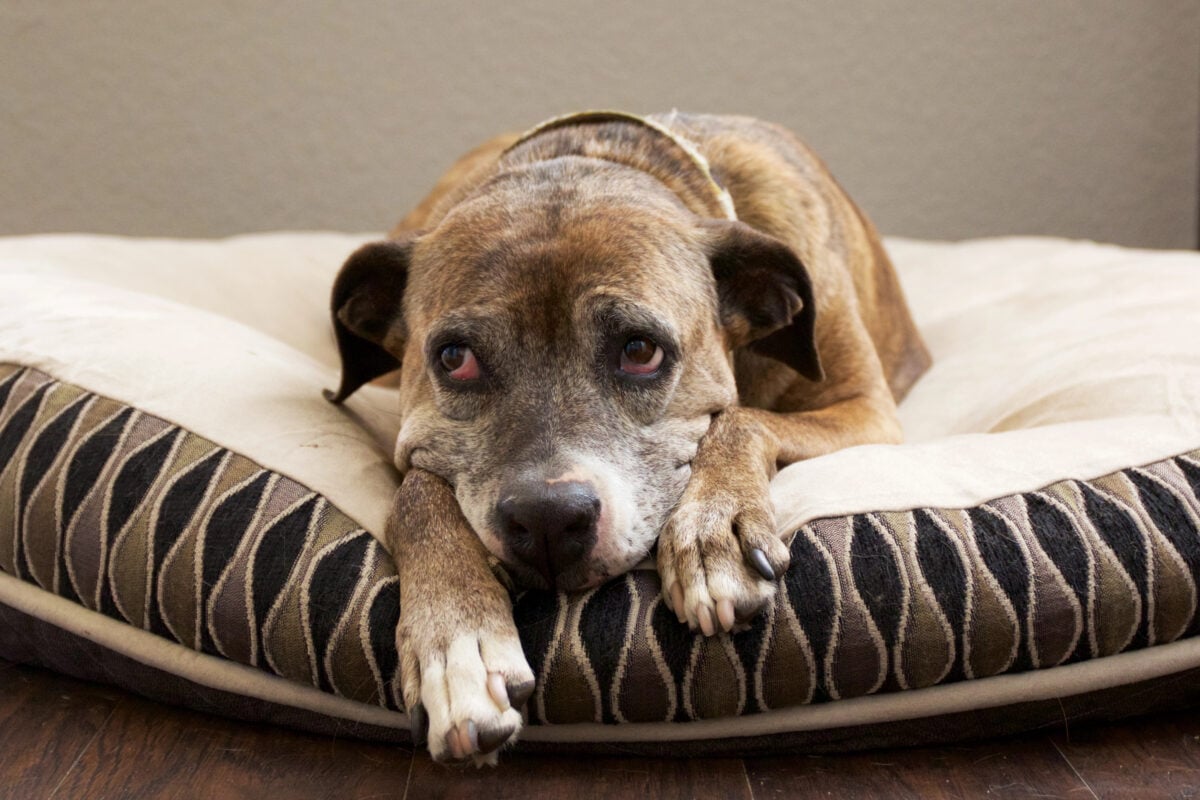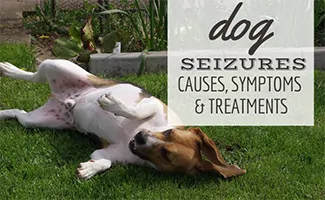Is Your Senior Dog Acting Strange? It Could Be Alzheimer’s Disease
When you purchase through links on our site, we may earn a commission. Here’s how it works.
Perhaps you’ve already noticed it. Your senior pup stands in the hallway staring at a wall or forgets which door leads outside. Maybe they pace at night, confused and restless, whining softly as if lost in their own home.
Table of Contents
It’s heartbreaking, and for many pet parents, it’s the unfortunate first sign of CCD (Canine Cognitive Dysfunction), the dog version of Alzheimer’s. Like humans, senior dogs face age-related brain changes that cause confusion and anxiety. The hardest part? They can’t tell us what’s wrong, and too often, it’s dismissed as “just old age.”
This topic hits close to home for me. My Cocker Spaniel mix, Tiny, is almost 14. Several months ago, he started hesitating in familiar spaces or pausing mid-routine, like he’d momentarily forgotten what comes next. It was subtle, but enough to make me wonder if these were early signs of something worse to come.
In this guide, I’ll break down what’s really going on inside your senior dog’s brain, the symptoms to watch for, and what you can do to keep them comfortable and connected as they age.
Do Dogs Really Get Alzheimer’s Disease?
Yes — dogs can develop a condition strikingly similar to Alzheimer’s disease in humans. In veterinary medicine, it’s called Canine Cognitive Dysfunction (CCD), and it’s more common than many pet parents realize.

With CDD, a dog’s brain is aging and starting to show a gradual cognitive decline. The systems that once allowed them to learn, navigate, remember, and socially engage are starting to falter.
Studies have shown that dogs naturally develop beta-amyloid plaques — sticky protein buildups that interfere with brain cell communication. These changes mirror the same biological processes seen in human Alzheimer’s patients, leading to confusion, disorientation, and altered behavior over time.
What The Statistics Reveal
- According to a study published in the Veterinary Journal, canine dementia affects an estimated 14% of dogs over eight years old, but is critically underdiagnosed by vets.
- Another study found that 28% of canines between 11 and 12 years old show at least one sign of cognitive decline syndrome. This increases to 68% in dogs over age 15.
- In a recent study by the Dog Aging Project, it was shown that dogs have a 52% higher chance of developing dementia every year they age past 10 (when other health variables are considered). Based on age alone (with no health variables considered), the chance increases to 68% for every year past their 10th birthday.
I first learned this when Tiny began hesitating before stepping outside. It wasn’t major, just enough to make me notice. When I mentioned it at his senior wellness visit, my vet nodded knowingly and said, “You might be seeing the very early signs of canine cognitive dysfunction.”
That moment made the research hit differently — this wasn’t just a medical statistic anymore.
The takeaway: Alzheimer’s disease in dogs isn’t just “old age.” It’s a real, progressive brain condition, and understanding it early gives you more time to adapt your care and keep your best friend’s world feeling familiar and safe.
What Causes Alzheimer’s In Dogs?
Just like human Alzheimer’s, CDD doesn’t come from one single cause. It’s the result of aging changes in the brain, made worse by things like poor circulation, chronic inflammation, and even reduced daily activity.
At its core, age is the biggest risk factor. Dogs over 8 years old are more likely to show early subtle cognitive changes, such as hesitation at doorways, confusion during walks, or sudden accidents indoors.
Inside Your Dog’s Aging Brain
Here’s what’s really happening behind the scenes as the years add up:
- Protein buildup: As dogs age, abnormal proteins (especially beta-amyloid plaques) start to collect in the brain. These sticky deposits interfere with nerve cell communication — the same biological process that drives Alzheimer’s in humans.
- Neuronal wear and tear: Over time, neurons lose their ability to “talk” efficiently. The brain’s waste-clearance system also slows, leaving behind debris that further disrupts function.
- Oxidative stress: Think of this as “rust” on brain cells — an imbalance between damaging free radicals and the antioxidants that protect against them.
- Reduced blood flow: Aging arteries can limit oxygen delivery to the brain, starving neurons of the fuel they need to stay sharp.
- Genetic and breed influences: A Dog Aging Project study found that terriers, toys, and non-sporting breed groups were more than three times as likely to be diagnosed with CDD compared to the other breed groupings.
- Overall health matters: Conditions like arthritis, hearing or vision loss, and chronic inflammation can accelerate brain aging and confusion.

Lifestyle plays a major role, too. Studies have found that the odds of CCD are more than 6 times higher in sedentary dogs than in active dogs.
Did You Know?
Dogs’ brains age similarly to ours — complete with protein buildup and oxidative stress. But staying mentally and physically active can slow decline! Even a 10-minute scent walk counts as mental exercise.
Spotting The Signs: Alzheimer’s Disease In Dogs Symptoms To Watch For
Dogs with Alzheimer’s disease don’t suddenly “lose” their memory overnight. The decline is gradual, and symptoms often sneak up so slowly that owners mistake them for normal aging. I know, because I did with Tiny.
But subtle changes in your dog’s behavior, sleep, or interactions can reveal what’s really going on. Veterinarians and pet owners often use the DISHAA questionnaire to identify the main categories of change:
- Disorientation
- Interaction with people and/or pets altered
- Sleep/wake cycles altered
- House soiling, learning, and memory
- Activity level altered
- Anxiety
When more than one of these areas begins to shift, it’s time to start keeping track and talk with your vet about CDD.
Early Signs
These are classic early indicators of cognitive decline:
- Mild disorientation: Standing in corners or getting “stuck” behind furniture.
- Changes in interaction: Acting distant, ignoring commands, or seeming less excited about playtime.
- Sleep-wake reversal: Restless at night, sleeping more during the day.
- House-training slip-ups: Accidents indoors, even when they’ve been trained for years.
- Anxiety or clinginess: Pacing, whining, or seeking constant reassurance.
- Forgetfulness: Struggling to recall familiar routines or cues.
Expert Tip: Keep a short “behavior journal” — note moments of confusion, nighttime pacing, or changes in appetite. It can help your vet determine whether it’s Alzheimer’s disease in dogs or another health issue that mimics it (like arthritis pain or vision loss).
Later-Stage Or Advanced Signs
As Alzheimer’s in dogs progresses, the symptoms become more pronounced and emotionally harder to watch. Dogs may seem physically present but “mentally elsewhere.” Tiny isn’t there yet, but my vet told me what to watch out for.
Common late-stage symptoms include:
- Severe confusion: Not recognizing familiar people or spaces.
- Nighttime pacing and agitation.
- Increased vocalization: Whining or barking for no obvious reason.
- Disrupted sleep: Awake most of the night, then exhausted by day.
- Loss of appetite or interest in play.
- Extreme anxiety or fearfulness.
- Frequent house soiling.
When dogs reach this point, they’re not “giving up” — their brain simply struggles to process information. Understanding this helps pet parents respond with patience, not frustration.

According to the American Animal Hospital Association’s Senior Care Guidelines, maintaining predictable structure and gentle enrichment can slow cognitive decline and preserve confidence in aging dogs.
Myth vs. Fact: Dog Dementia
Myth:
“It’s normal for older dogs to get confused or have accidents — that’s just part of aging.”
Fact:
Occasional forgetfulness can happen with age, but repeated disorientation, pacing, or nighttime restlessness are signs of CCD — the dog version of Alzheimer’s disease.
Early intervention with vet-approved diets, mental enrichment, and medication can slow progression and greatly improve quality of life.
What Is Sundowning In Dogs? Why Nights Feel Harder
If your senior dog seems fine most of the day but becomes restless, anxious, or disoriented after sunset, you’re not alone. Many dogs with cognitive decline experience something called “Sundowner Syndrome,” or sundowning, a pattern where confusion and agitation increase as daylight fades.
It’s one of the most frustrating parts of Alzheimer’s disease in dogs, and often the moment when pet parents realize something deeper than “old age” might be happening.
Common Sundowner Behaviors
- Pacing or wandering around the house once it gets dark
- Restlessness or panting as the family winds down
- Barking or whining seemingly at nothing
- Difficulty settling in their usual sleeping spot
- Accidents indoors overnight
- Clinginess or anxiety, especially when the lights go out

Why Do Symptoms Get Worse At Night?
Veterinary neurologists aren’t entirely sure why Sundowning happens, but it’s thought to involve changes in the brain’s internal clock and the loss of normal day–night rhythm regulation. Here’s what current research suggests:
- Light sensitivity changes: Aging eyes and brain receptors struggle to process shifts in light, confusing your dog’s sense of time.
- Reduced melatonin production: Just like humans, senior dogs produce less of this sleep-regulating hormone, which can throw off their circadian rhythm.
- Cognitive fatigue: As the day wears on, dogs with Alzheimer’s have a harder time processing information — similar to “decision fatigue” in people.
- Anxiety and disorientation: Darkness and quiet amplify confusion, leading to restlessness or fear behaviors.
When Is It Time To Contact My Vet?
No one knows your dog better than you do, so you’ll often be the first to sense that something isn’t right. But when those little quirks start adding up (confusion, accidents indoors, pacing at night), it’s time to bring your vet into the conversation.
You don’t need to wait until things feel “serious.” Early evaluation can slow progression and help you adapt your care plan before symptoms intensify. If you’ve been journaling your dog’s behavior, bring those notes. They’re invaluable for spotting patterns that may not show up during a quick office visit.
Ask Yourself These Questions
Before the appointment, reflect honestly on your dog’s daily behavior. Your answers can help your vet determine how advanced the condition might be:
- Has your dog become disoriented in familiar places or around the house?
- Have you noticed changes in how they interact with family members or other pets?
- Are they awake and pacing at night, or napping excessively during the day?
- Have there been accidents indoors, even though they’re normally house-trained?
- Do they seem more anxious or clingy than before?
- Are they struggling to learn new commands or routines?

If several of these sound familiar, it’s worth booking a senior wellness exam. Your vet may recommend a neurological assessment or run lab work to rule out other causes (like thyroid imbalance or sensory loss).
How Do Veterinarians Diagnose CCD?
Diagnosing Alzheimer’s in dogs isn’t as simple as running one test. Instead, veterinarians use a combination of behavioral evaluations, physical exams, and lab work to rule out other causes of confusion.
Because CCD shares symptoms with several other senior-dog conditions, including arthritis pain, hearing or vision loss, thyroid disease, and brain tumors, your vet’s first goal is to rule out reversible issues before confirming dementia.
Step 1: Detailed History & Behavior Screening
During the evaluation, your vet might use scoring tools such as the Canine Dementia Scale (CADES) or a full DISHAA worksheet to grade your dog’s cognitive function. Your observations matter more than anything.
These tests categorize decline into four levels:
- Normal aging – Minor, age-appropriate forgetfulness.
- Mild cognitive impairment – Occasional confusion or restlessness.
- Moderate impairment – Noticeable behavioral and sleep disruptions.
- Severe impairment – Frequent disorientation, vocalization, or house soiling.
Step 2: Physical & Neurological Exam
Next, your vet may perform a full physical exam to check for pain, vision or hearing deficits, and neurological reflexes. Bloodwork and urinalysis rule out metabolic causes like kidney disease or diabetes, both of which can mimic confusion and disorientation. Some clinics may recommend advanced imaging (MRI or CT scans) if a structural brain issue needs to be excluded.
Step 3: Building a Baseline
Once CCD is suspected, your vet will help you establish a behavioral baseline — a record of current symptoms, diet, medications, and activity level. This baseline becomes invaluable for tracking whether treatments are helping over time.
If you’re managing early-stage cognitive decline, schedule regular check-ins every six months. Small changes in sleep, orientation, or interaction can signal whether your management plan needs adjustment.
Treating Alzheimer’s Disease In Dogs: What Really Helps (And What Doesn’t)
There’s no single cure for Alzheimer’s disease in dogs, but there are many ways to slow its progression and ease your dog’s symptoms. The goal is to protect their quality of life, reduce anxiety, and keep your senior pup connected to the world they love.
Most treatment plans involve a combination of medication, diet, supplements, and lifestyle adjustments. Your vet will help you tailor each piece to your dog’s specific needs.
1. Prescription Medications
The most common drug prescribed for CCD is selegiline (brand name Anipryl), a medication that increases dopamine levels in the brain. Dopamine supports alertness, motivation, and focus.
Many dogs on selegiline show noticeable improvement in activity, awareness, and engagement within several weeks.
Additional medications may include:
- Melatonin: helps regulate sleep-wake cycles
- Nicergoline: improves blood flow to the brain
- S-adenosylmethionine (SAMe): supports brain chemistry and mood
Pro tip: Medication works best when started early, before severe disorientation sets in. If your vet suspects mild cognitive decline, discuss whether a short medication trial could help.
2. Diet & Brain-Healthy Nutrition
Nutrition plays a huge role in supporting the aging brain. Look for senior dog foods rich in DHA for brain cell health and plenty of antioxidants like vitamins E and C to fight oxidative stress.
Prescription dog foods, such as Hill’s Prescription Diet b/d and Purina Pro Plan Veterinary Diets NC NeuroCare, are specifically designed to improve alertness and cognitive function in older dogs.
Helpful link: Explore our best senior dog foods for top formulas that include brain-boosting nutrients.

3. Supplements That Support Cognitive Health
If prescription food isn’t an option, ask your vet about neuroprotective supplements. Some of the most commonly used include:
- S-adenosyl methionine (SAMe): an antioxidant that supports healthy brain and liver function.
- Phosphatidylserine: A natural phospholipid that helps protect nerve membranes.
- Ginkgo biloba: an herbal extract that supports circulation and cognitive function.
- Omega-3 fish oil: Provides DHA and EPA for brain and heart function.
- Antioxidant blends with vitamins E, C, and selenium.
- Medium-chain triglycerides (MCTs), which provide an alternate energy source for aging brain cells
Expert Tip: Always consult your vet before starting supplements because some can interact with existing medications or can upset sensitive stomachs.
4. Lifestyle & Environmental Changes
Small daily adjustments can dramatically improve comfort and orientation for dogs with cognitive decline.
Try these simple changes (keep reading for more details below):
- Keep routines predictable to reduce confusion
- Provide safe, open walking paths inside the house
- Take daily walks at your dog’s pace
- Use puzzle toys, snuffle mats, or short training sessions for mental exercise
Myth vs. Fact: Treating Alzheimer’s Disease In Dogs
Myth:
“Once my dog shows signs of dementia, there’s nothing I can do.”
Fact:
While there’s no cure for Alzheimer’s disease in dogs, early treatment can slow progression and restore alertness. Prescription medications like Anipryl (selegiline), brain-boosting diets, and consistent daily routines often bring noticeable improvement — even in older dogs.
Small changes truly can make a big difference in how connected and comfortable your senior pup feels.
Prognosis & What To Expect
With early intervention, many dogs live happily for months or even years after diagnosis. The key is consistency and compassion — understanding that forgetfulness or nighttime pacing isn’t stubbornness, but a sign of how their brain is changing.
Some days will be better than others. Celebrate the good ones, and remember: the comfort of a familiar voice, a warm bed, and gentle routine can still mean everything to an aging dog.
And remember, there is hope with your help. Check out this promising video of an adorable pup with CCD, who improved after taking MCT supplements, according to the Purina Institute.
Planning Ahead: Pet Insurance For Senior Dogs
Managing Alzheimer’s disease in dogs often means more frequent vet visits, lab work, and prescription costs, all of which can add up quickly. If your dog hasn’t started showing definite signs yet, now is the time to explore pet insurance and Rx coverage.
While some providers restrict eligibility to a maximum age of 14 years old, many of the best pet insurance companies have no maximum age restrictions. However, most providers don’t cover pre-existing conditions, so waiting until after symptoms begin and a diagnosis is made could limit your options.
Even if coverage doesn’t include cognitive decline itself, it can still offset costs for care related to other unforeseen illnesses and accidents that arise.
6 Simple Things You Can Do At Home To Help Your Dog Feel Safe
Caring for a dog with Alzheimer’s disease can feel overwhelming at first, but small, consistent adjustments can make a huge difference. Your goal isn’t to “fix” the condition; it’s to help your dog feel safe, loved, and oriented in their daily routine.
These simple strategies can help bring calm and structure back into your home.
1. Stick To A Predictable Routine
Dogs with cognitive decline rely heavily on familiarity. Keep mealtimes, walks, and bedtime at the same hour each day. Consistency builds a sense of security when your dog’s memory starts to falter.
Tip: If your schedule changes, try to maintain at least one “anchor” event your dog can count on, such as a nightly treat before bed or a morning walk around the same block.
2. Create A Calm, Safe Space
As confusion increases, your dog may startle more easily or wander into tight spots. A calm environment helps prevent anxiety and reduces nighttime pacing.
- Use dog gates to block off stairs or areas with obstacles.
- Keep nightlights in hallways and near sleeping areas.
- Provide a soft, calming dog bed away from heavy foot traffic.

3. Keep Their Mind Engaged
Even small bursts of mental stimulation can help maintain brain function. Try:
- Food puzzles or snuffle mats for slow, thoughtful eating.
- Hide-and-seek games with treats.
- Interactive dog toys for self-guided stimulation.
- Gentle scent walks where your dog can explore at their own pace.
Helpful link: See our guides to brain games for dogs and video games to help with canine dementia for more enrichment ideas that suit senior pups.
4. Offer Comfort Through Connection
Touch, tone, and presence go a long way. Dogs with cognitive decline often crave reassurance from their favorite humans. Even if your dog seems “distant” at times, your calm presence helps them feel anchored.
- Keep interactions soft and calm — sudden loud voices can increase confusion.
- Offer gentle massage or brushing sessions.
- Use verbal cues consistently so they associate your voice with comfort.
5. Manage Household Stressors
Noise, clutter, and chaos make life harder for a confused dog. Try keeping the TV volume low, using background music, and avoiding rearranging furniture. If you host guests, let your dog rest in a quiet room with a familiar blanket or toy.
6. Keep Communicating With Your Vet
Your dog’s needs will change as the condition progresses. Regular check-ins help your vet adjust medication, diet, and supplements to match their stage of decline. Write down any new behaviors you notice — even small ones can guide care decisions.
Frequently Asked Questions About Alzheimer’s In Dogs
Pup owners have so many questions about dementia in dogs. Here are some of the most common we see. If your question isn’t included here, please ask us in our comments. We’ll do our best to help you!

What Are The First Signs Of Alzheimer’s Disease In Dogs?
The earliest signs are often subtle — things like confusion in familiar spaces, restlessness at night, or hesitating before going outside. Many dogs also start having accidents indoors or seem less responsive to their name.
If you’re unsure whether it’s normal aging or CCD, jot down daily behaviors for a week and share them with your vet.
What’s The Difference Between Canine Cognitive Dysfunction & Vestibular Syndrome?
Both conditions can cause imbalance, confusion, or changes in appetite, but they are not the same.
- Vestibular syndrome comes from an inner ear or brain abnormality that disrupts balance.
- Canine cognitive dysfunction comes from age-related brain changes that affect memory, orientation, and behavior.
If your dog appears wobbly, your veterinarian can help determine the underlying condition.
Do Dogs With Alzheimer’s Bark A Lot?
Yes, many bark excessively. They may bark at “nothing” or vocalize more out of fear and confusion. Barking is often how they communicate when they feel lost or anxious.
Instead of raising your voice, try to calm them with a soothing tone, gentle touch, or a consistent routine. This reassurance often helps more than correction.
How Long Can Dogs Live With Alzheimer’s Disease?
Most dogs with mild to moderate CCD can continue living happily for months or even years after diagnosis, especially with early intervention. Regular vet checkups, stable routines, and nutritional support all help preserve quality of life.
Can Dogs With Alzheimer’s Still Be Happy?
Absolutely. Even as cognitive changes set in, dogs continue to experience comfort, joy, and connection through familiar voices, routines, and affection. Keeping their environment calm and predictable allows them to feel secure, and your companionship remains their greatest source of happiness.
Helping Your Senior Dog Live A Healthy, Happy Life
Caring for a dog with Alzheimer’s disease is never easy, but understanding what’s happening inside their mind helps you meet them with patience and compassion. Small changes, such as steady routines, brain games, and the right nutrition, can make every day a little brighter.
Related reads:
Have you cared for a dog with cognitive decline? Share your experience in the comments — your story may help another pet parent feel less alone.




